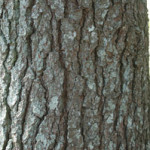Description:
Eastern White Pine ( Pinus strobus) is a hardy and valuable conifer. The largest of the northeastern conifers, a magnificent evergreen with straight trunk and and a crown of horizontal branches: 1 row added each year. Prized for it’s lumber Eastern White Pine has been used for construction, millwork, trim, and pulpwood. Younger trees have replaced the once seemingly inexhaustible supply of virgin forests. The tall straight trunks were prized for ship masts in the colonial period.

There are very few stands of virgin , old growth white Pines left in the north east. This young stand is typical of what you will find.
Recognize White Pine by it’s soft, blue-green needles that grow five in a cluster, and 2.5-5″ long. The bark is grey and smooth, becoming rough, thick and deeply furrowed into narrow scaly ridges. The cones of White Pine are long and narrow, yellow brown: typically 4-8″ long.
Height: 100′ is typical but 150′ was the standard of virgin stands before clear cutting.
Diameter:3-4′ or more
Habitat: Well drained sandy soils: sometimes in pure stands
Range: SE. Manitoba east to Newfoundland, south to N. Georhia and west to NE Iowa: a variety in Mexico. From near sea level to 2000′ : in the southern Appalachians to 5000′
- Cones are 4-8″ and slender-scales are thin rounded and flat
- Bark is grey, smooth becoming rough, thick and deeply furrowed into narrow scaley ridges.
- Range of White Pine





Comments
I am growing ship masts here on my property!
White pine is so common that I did not think to plant any, but in the past couple years I have added some out in the meadow and they are wonderful to watch as they grow. They add size pretty fast, so that’s rewarding, and I can trim them for fullness, so I enjoy doing some “tending”. In a few years I can start supplying the shipbuilders : )
Hi Laurrie. White Pine is an easy one to overlook when planting a tree as they are so common already here in the Northeast. It really can be a nice tree in the right application. I really like the soft look and feel of the needles.
I will tell my mates on the Peacemaker to pay you a visit in a few years to work out a deal on those masts.